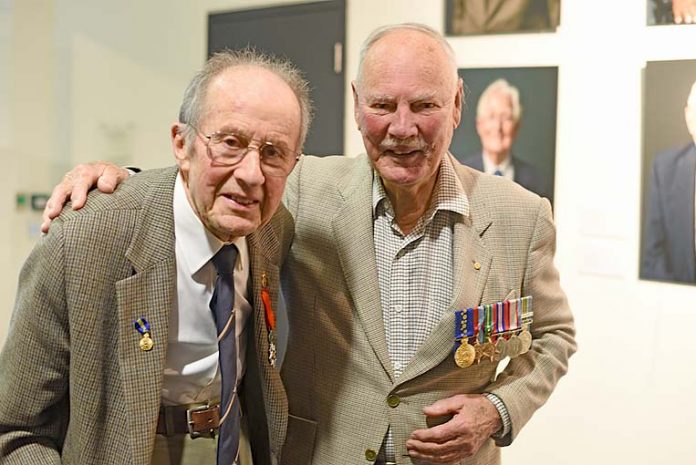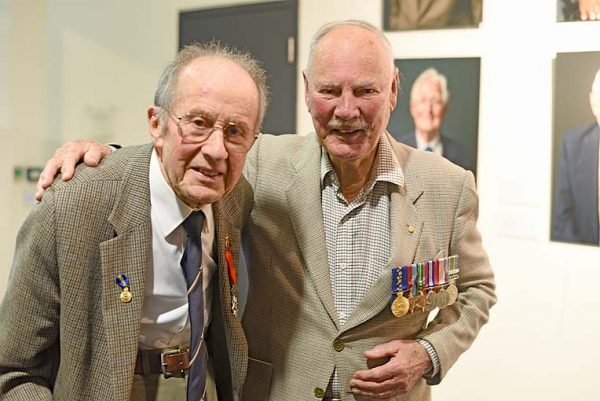

MOUNT Gambier World War II veteran and renowned photographer Eric Arthur OAM has been honoured in a special ceremony in England commemorating the bravery of those involved in daring low-level bombings of Nazi targets.
Mr Arthur – who passed away earlier this year – was honoured at the war memorial that marks the intersection of the remains of the old runways at the former Royal Air Force Woodhall Spa Airfield in Lincolnshire.
This is where Mr Arthur flew his 44 bombing operations with 627 squadron in Bomber Command Pathfinder Force.
RAF Woodhall Spa was also home to 617 Lancaster squadron, better known as the Dambusters.
The occasion was a remembrance ceremony for the 75th anniversary of the combat death of Wing Commander Guy Gibson VC, the legendary Commanding Officer of the Dambusters and his navigator Jim Warwick.
Mr Arthur’s son Alan Arthur said his family was pleased Eric was commemorated in a special way.
“We are touched by this honour and that people in England – who had never met Eric – were so appreciative of his service defending their country and had so much respect for him they would honour him alongside one of the legends of the RAF,” Alan said.
He said his father was the last man standing from combat operations with 627.
“A resident of the Woodhall Spa area with a keen interest in the history of the squadrons at Woodhall Spa and appreciation of what they did for us, got in touch with Eric last year,” Alan explained.
“Aware of Eric’s recent death, he sought permission to include Eric in the ceremony to commemorate Gibson and Warwick and so Eric was added as a third part of the ceremony.”
The remnants of RAF Woodhall Spa have been turned into a public wildlife refuge, which includes the war memorial as a centrepiece.
According to details supplied to The Border Watch, Gibson was a Lancaster pilot by training and experience and in September 1944, while stationed at nearby airfield, Gibson “borrowed” a Mosquito from 627 squadron to use to be Master Bomber for a raid.
Master Bombers directed the operation of a raid over the target and used Mosquitos as the most versatile plane for the job.
While flying at low level on the way home from the raid, Gibson’s Mosquito crashed, killing him and Warwick.
The death of Gibson was a morale blow to the Allies and a propaganda coup for the Nazis with a number of claims being made for shooting him down.
But Eric was of the view Gibson was not shot down and his crash was a tragic self inflicted accident caused by Gibson and Warwick not being familiar enough with operations of a Mosquito as they were both Lancaster men.
Eric was of the view Warwick had mistakenly turned off the fuel for the engines instead of switching to a fresh tank.
Mr Arthur – who died at the age of 96 – was a decorated war hero and community-minded individual.
In particular, he will leave a lasting legacy through his extensive collection of photographs that captured the Blue Lake city’s rich history.
The decorated war veteran was awarded the Legion of Honour with the rank of Chevalier (Knight) by the French Government in 2016.
Mr Arthur – who received the highest award France bestowed for civilian or military service – navigated a “Pathfinder” Mosquito bomber for the RAF’s 627 Squadron.
Demonstrating immense bravery and skill, the Pathfinder Force conducted low-level attacks on targets in Nazi-occupied Europe between D-Day and the end of World War II.
The talented flying officer took part in a staggering 44 flying operations in just one year.
Mr Arthur is also remembered for his significant contribution to capturing Mount Gambier’s history through the lens.
In an extraordinary gift, Mr Arthur donated his entire collection of more than 6500 photographs to the State Library of South Australia.
His most famous photograph was taken when assigned to document the Queen during her tour of the Blue Lake in 1954, which was shown around the world.







